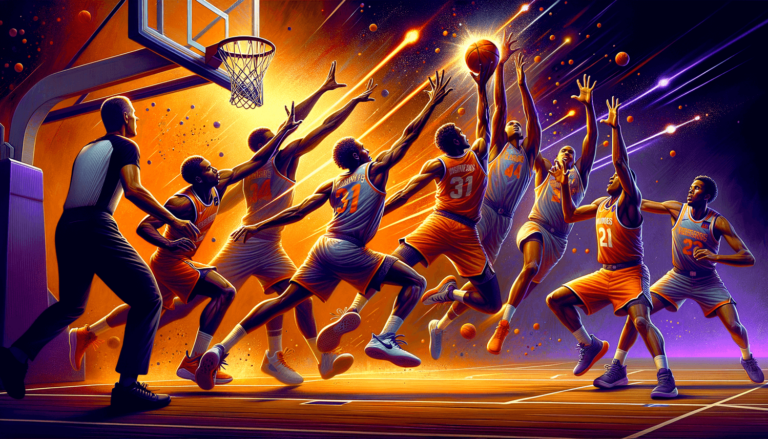
Reach-In Foul Rule in Basketball: What You Need to Know
Written by: Basketball Universe
Last updated:

If there’s one thing both basketball players and fans can’t afford to overlook, it’s understanding the intricacies of the game’s rules ─ especially when it comes to fouls. The reach-in foul, a commonly misunderstood and debated call, plays an essential role in maintaining the sport’s competitive nature. Our in-depth exploration of the reach-in foul rule is designed to not only take your basketball prowess to new heights but also facilitate both passionate conversations and informed decisions on and off the court. So lace up, grab a snack, and let’s dive into everything you need to know about this pivotal aspect of hoops!
Reach-In Foul Rule in Basketball: What You Need to Know
A reach-in foul in basketball occurs when a defensive player, in their attempt to steal the ball, makes illegal contact with their opponent, often involving excessive or aggressive arm extension towards the ball handler. This call aims to maintain fairness and safety in the game, ensuring that defensive players abide by proper defensive stance and avoid overly aggressive tactics that could lead to injuries or disrupt the flow of the game.
Why Understanding the Reach-In Foul Rule Matters
Before we delve into the specifics of the reach-in foul, it’s crucial to establish why it’s important for everyone involved in the game, from players, coaches, and referees to even avid fans. A comprehensive grasp of the reach-in foul rule ─ and basketball rules in general ─ facilitates clearer communications and aligns expectations between all parties. It helps players focus on honing their defensive skills within the game’s parameters and ensures a safer and more enjoyable experience for everyone involved.
Anatomy of a Reach-In Foul: Breaking it Down
Understanding the reach-in foul rule begins with dissecting its various components. To clarify all you need to know about this rule, we’ll look at its fundamental elements:
Illegal Contact
Illegitimate contact is the defining aspect of a reach-in foul. When a defensive player’s arm excessively extends to reach beyond their torso or body and makes contact with the offensive player or the offensive player’s arm, it constitutes a reach-in foul. It’s essential to note that the slightest touch doesn’t necessarily warrant a foul. Rather, the level of impact must be substantial enough to affect the ball handler’s movement or control of the ball, which often lies in the referee’s discretion.
Defensive Stance and Positioning
A crucial determinant of a reach-in foul is the defensive player’s stance and positioning. Proper defensive posture involves bending the knees and maintaining a balanced, low stance. This allows players to move laterally and stay in front of their opponents while keeping their hands out to either side. Maintaining appropriate positioning can not only prevent reach-in fouls but also increase a player’s likeliness of intercepting passes or securing steals in a legal manner.
Referee’s Perception and Decision-Making
In basketball, referees shoulder the responsibility of upholding the rules, and their perception significantly influences the game’s pace and outcome. Naturally, there exists some variability in how individual referees perceive reach-in fouls, and the level of contact they consider as detrimental. A keen understanding of the reach-in foul allows referees to make well-informed decisions that maintain the game’s integrity and flow.
Reach-In Fouls: A Closer Look at Personal Fouls and Team Fouls
Investigating the consequences of reach-in fouls, and how personal and team fouls come into play, can further expand our understanding of this topic.
Personal Fouls
A personal foul is a type of violation committed by a player against an opponent. Each player is allowed a certain number of personal fouls, which varies depending on the level of play and governing basketball organization. When a player commits a reach-in foul, it is recorded as a personal foul. If a player accumulates too many personal fouls during a game ─ typically five in high school and college, and six in the NBA ─ they “foul out” and can no longer participate in the match.
Team Fouls and Bonus Situations
When a reach-in foul occurs, it also contributes to the fouling team’s total team fouls. In a single period, if a team has accumulated a predetermined number of team fouls ─ such as seven in college basketball ─ the opposing team enters a bonus situation. Once in the bonus, the team is rewarded with free throws for each subsequent foul committed by the opposition until the period ends. By understanding the implications of team fouls, players can strategize more effectively and avoid unnecessary penalties that could shift the game’s momentum.
Mastering Proper Defense: How to Avoid Reach-In Fouls
While the reach-in foul rule may seem daunting, it doesn’t have to be a source of concern for defensively-minded players. By mastering proper defensive techniques, it’s possible to minimize the risk of committing reach-in fouls while maximizing your ability to legally disrupt the opposing team’s offense.
Maintain a Solid Stance, and Avoid Lunging
Historically, defensive legends have consistently followed one vital principle: maintaining a strong stance. By bending your knees, staying low, and keeping your hands out to your sides, you can maintain a balanced, robust defensive position. This stance not only allows for more agile lateral movements but also reduces the temptation to lunge or overreach for the ball, mitigating the chances of committing a reach-in foul.
Patience and Timing: Picking Your Moment
Successful defense hinges on the art of patience and timing. Opportunistic grabs at the ball may lead to more reach-in fouls and compromised defensive positioning. By waiting for the right moment ─ such as when your opponent exposes the ball or incorrectly positions their upper body ─ you can increase your chances of legally securing a steal without drawing the whistle.
Trust Your Team: Working Cohesively
You don’t have to carry the burden of defense on your own. Basketball is a team sport, and a coordinated, cohesive defensive unit can amplify each player’s individual effectiveness while reducing the urge to commit reach-in fouls. Trust your teammates to provide help-side defense and support, and work together to effectively disrupt the offense without resorting to overly aggressive tactics.
FAQs on Reach-In Fouls: Quick Answers for Curious Fans
Let’s address some frequently asked questions about reach-in fouls to demystify the topic and address any lingering doubts or uncertainties.
Can Offensive Players Commit Reach-In Fouls?
No, reach-in fouls are specific to defensive players who attempt to swipe at the ball or interfere with the ball handler in an illegal manner. Offensive players can commit other personal fouls, such as charging, pushing-off, or illegal screens, but not reach-in fouls.
Are “Reaching” and “Reach-In” Fouls the Same Thing?
Yes, “reaching” and “reach-in” fouls are often used interchangeably, and both refer to the same violation. Some terminology varies across regions, but the fundamental concept remains consistent across the basketball world.
Is Every Reach-In Foul Called Equally?
While basketball rules strive for consistency, referees call reach-in fouls based on their perception of the play, which can be subject to slight variations. However, by understanding the guiding principles behind the reach-in foul rule, experienced referees maintain a high level of consistency and fairness within the game.
Armed with this comprehensive understanding of the reach-in foul rule, you can now approach the game more informed, engaged, and focused on developing skills that comply with basketball’s rules and ethics. Whether you’re a player, coach, referee, or a passionate fan, increasing your knowledge about basketball rules can only enrich your love for the game and enhance your overall experience.
Debunking Common Misconceptions about Reach-In Fouls
Several misconceptions surrounding reach-in fouls can confuse players, coaches, and fans alike. Let’s dispel some of the most common ones:
Myth: A Reach-In Foul Occurs if the Defender’s Hand Crosses an Imaginary Plane
Reality: There is no imaginary plane that marks the border between legal and illegal defense. Instead, the determining factor for a reach-in foul is whether there is sufficient contact with the offensive player or their arm, and if the defensive player inappropriately extends their arm beyond their body.
Myth: All Reach-In Fouls are Called when a Player Swipes and Misses the Ball
Reality: While swiping at a ball and missing can lead to a reach-in foul, the issue isn’t the failure to make contact with the ball. The critical component is the illegitimate contact made with the opponent’s body or arm, or the defensive player’s excessive arm extension. Intelligently positioning your hands and playing defense without carelessly reaching can help avoid reach-in fouls.
Distinctive Reach-In Fouls in Different Levels of Play
It’s worth noting that certain nuances and differences exist in how reach-in fouls are called in different levels and styles of basketball. Being aware of these distinctions can be beneficial for players, coaches, and fans.
FIBA vs. NBA
While the core principles behind the reach-in foul rule remain consistent across the globe, FIBA and NBA officiating can have differences in their calls. Generally, FIBA referees are stricter when it comes to calling reach-in fouls, while the NBA may allow slightly more physical play. Understanding the governing body’s style can help you adapt to its specific rules and expectations.
High School and College Basketball
In high school and college basketball, emphasis is often placed on promoting a safe and controlled playing environment. Consequently, referees might lean towards calling reach-in fouls more strictly in these leagues compared to higher-level competition. Maintaining good form and prioritizing proper defensive principles is vital to avoiding penalties in this context.
Awareness of Basketball Rules: The Key to Better Basketball Experience
The reach-in foul rule plays an integral part in basketball, and a sound understanding of this regulation can boost not only your performance but also your enjoyment of the sport. By incorporating the knowledge garnered about reach-in fouls into your game, you can foster a safer, fairer, and more entertaining basketball experience ─ on and off the court.
Frequently Asked Questions about Reach-In Fouls
It’s natural to have questions about the reach-in foul or other aspects of basketball. We’ve compiled a list of ten common questions that cover important and related concepts, providing you with NLP-style answers for a concise understanding.
1. What is the primary purpose of the reach-in foul rule?
The main objective of the reach-in foul rule is to maintain a safe, fair, and competitive basketball environment, preventing overly aggressive tactics by enforcing proper defensive positioning and techniques.
2. How does a referee determine whether to call a reach-in foul?
Referees assess reach-in fouls based on the defensive player’s contact with the offensive player or their arm, and the extent of the arm extension. The contact must be substantial enough to affect the ball handler’s movement or control of the ball.
3. Can a reach-in foul be committed without making physical contact with the offensive player?
No, a reach-in foul requires illegal contact with the offensive player. Without physical contact, a reach-in foul cannot be called.
4. How can defensive players avoid reach-in fouls while still effectively applying pressure on the ball handler?
Defensive players can avoid reach-in fouls by maintaining a proper defensive stance, exercising patience and timing for the right moment, and working cohesively with their teammates to disrupt the opponent’s offense.
5. What are the consequences of committing reach-in fouls in terms of personal and team fouls?
Committing a reach-in foul results in a personal foul for the player and contributes to the team’s overall foul count. Exceeding the personal foul limit can lead to a player fouling out, while exceeding team fouls can trigger bonus situations for the opponent.
6. Can a reach-in foul be committed on a player without possession of the ball?
Typically, a reach-in foul occurs during a defender’s attempt to steal the ball from the opponent. However, if a defensive player makes illegal contact while reaching towards an offensive player without possession, it can still be considered a personal foul, though not specifically a reach-in foul.
7. What are some other common personal fouls committed by defensive players?
Defensive players can commit various personal fouls, including blocking, charging, and holding. Each type of personal foul is enforced differently and contributes to a player’s personal and team foul count.
8. Are reach-in fouls called more frequently at certain levels of play?
The frequency of reach-in foul calls can vary between different levels of play. High school and college leagues often emphasize a safer playing environment, resulting in stricter enforcement of reach-in fouls compared to professional leagues like the NBA or FIBA.
9. Can a reach-in foul lead to an immediate loss of possession?
While a reach-in foul does not directly result in an immediate loss of possession, it halts the play and may have indirect consequences if the offending team has accumulated enough fouls to send the opposing team to the free-throw line.
10. Can a reach-in foul be committed during a jump ball?
Although less common, a reach-in foul can occur during a jump ball situation if a defensive player makes substantial illegal contact with an opposing player or their arm during their attempt to secure the ball.
Featured Posts
- No pillar pages found.





